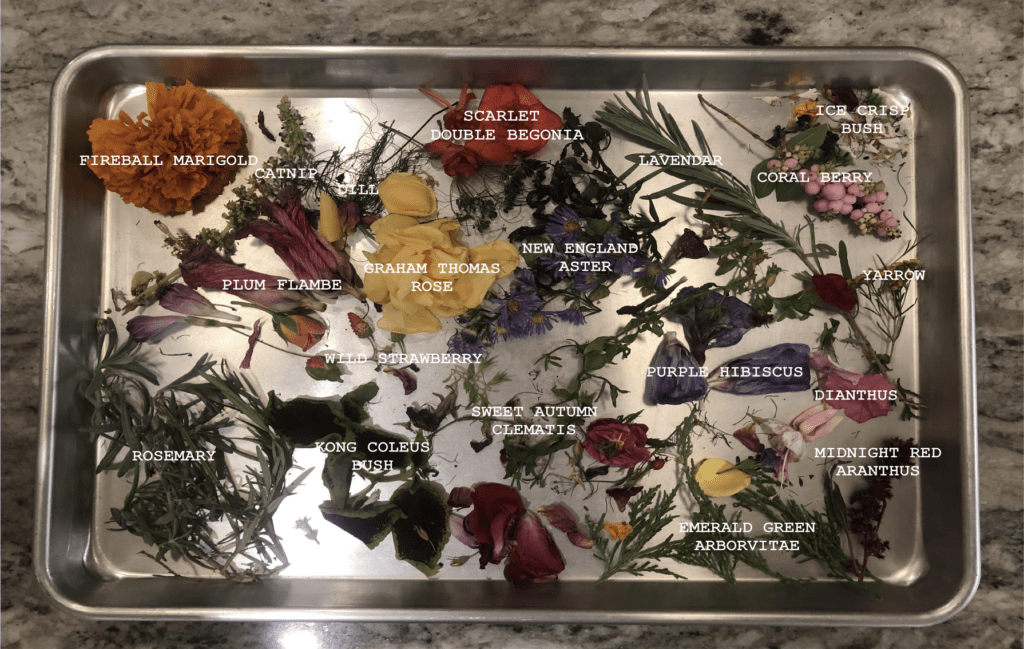Rita Rui Ting Wang, Smell the Soil
http://www.rwrita.com/smellthesoil
Gilad Dor, Appendage
https://theorganicutilitypole.com/CARDBOARD-DEVICES

Intending to create a machine that asks a question of an environment, I intended to frame what is happening to us in our overly surveilled world so that others are aware of it. Ultimately creating an appendage that works as an intermediary between the surveillor and the surveilled.
Gabriella M. Garcia, P.L.A.N.T Journal

How to subvert the idea of “data” as a purely observational object? What does interpersonal data look like? How can one experience it, share it? How can collected data connect place, narrative, and memory?
I collected samples of numerous plants along the block. I encountered some volunteer caretakers, who were called in for pruning and watering because “people are still coming by to take pictures” and they graciously helped me with my data collection. I then used a tincture method to draw the scent out of my collected dataset, creating a fragrant memory piece of the Greenest Block in Brooklyn.
Lydia Jessup, Measuring Device: Rain Garden
https://www.lydiajessup.me/fall-2019-post-natural/2019/10/2/measuring-device-rain-garden
Rain Gardens (bioswales) are a form of green infrastructure built to improve street drainage, sewer system overflow and water quality in New York City waterways. They require extensive engineering to build and are actively maintained by the city and volunteer Garden Stewards. Anyone can apply to be a Garden Steward, and depending on the volunteer’s experience, the City provides training on how to perform simple maintenance a few times a month, carry out sediment removal and weeding, and organizing planting events.
What is striking about Rain Gardens is that they invisible infrastructure. Underneath their surface are imperceptible flows, a living spongy world made of dirt, rocks, gravel doing hidden work as part of a larger water ecosystem. One of the goals of the project is to unearth and bring to the surface what is underground. I have primarily done this by applying the ideas from Spongiform, an article by anthropologist Andrea Ballestero, to the NYC rain gardens context.
Like Ballestero’s aquifers, the presence of the rain garden fuzzes the the boundary between our lives and the NYC waterways. By acting as a permeable layer with multi-dimensional movement and flows, it destabilizes our conceptual model of the solid water system made of concrete, gutters and pipes.
In this project I ask: how could this device…
-
Expand the boundary around citizenship to include maintenance of systems?
-
Make inputs and outputs explicit in order to re-draw the boundary of the Rain Garden?
This project addresses these questions by making the rain garden data part of the visible aspects of the infrastructure. How does this type of intervention adjust our volumetric understandings of what is below our feet and how we are connected to New York City water ecosystem? My hope is that this project prompts the passerby to acknowledge that both they and the rain garden are actors in the same system.
The agency in this interaction lies with the steward. The communication of information is mediated by the garden steward who takes measurements with the device. In this interaction I was hoping that the steward would go inside the garden and get close to the dirt, literally making themselves part of the infrastructure.
Alejandro Ribadeneira, Air Trap
https://medium.com/designing-the-postnatural/measuring-device-aa6542c088ef




Air Trap is a system that aims to visualise solid particles in the air at a specific location and time period by capturing them in an adhesive surface.
This project stemmed from my interest in having a better understanding about what came into my body through breathing and how these elements varied depending on where I stood. Similarly, I hoped to display “air” in a visual manner — a mixture of gases that are often seen as invisible, and even mysterious to me.
However, as the project developed, it became clear that I had to create limits in order to create a more precise device. Therefore, I decided to implement small, stealthy tools commonly used as mouse or insect traps to attract, and measure, particles in the air at specific locations and moments.




